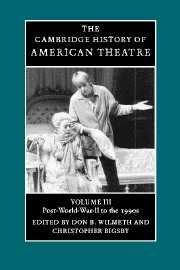Book contents
- Frontmatter
- Introduction
- Timeline: Post-World War II to 1998
- 1 American Theatre in Context: 1945–Present
- 2 A Changing Theatre: Broadway to the Regions
- 3 The Plays and Playwrights
- 4 Musical Theatre since World War II
- 5 Directors and Direction
- 6 Actors and Acting
- 7 American Theatre Design Since 1945
- Bibliography
- Index
5 - Directors and Direction
Published online by Cambridge University Press: 28 March 2008
- Frontmatter
- Introduction
- Timeline: Post-World War II to 1998
- 1 American Theatre in Context: 1945–Present
- 2 A Changing Theatre: Broadway to the Regions
- 3 The Plays and Playwrights
- 4 Musical Theatre since World War II
- 5 Directors and Direction
- 6 Actors and Acting
- 7 American Theatre Design Since 1945
- Bibliography
- Index
Summary
Introduction
The end of World War II did not instantly create a revolution in American stage direction, but it would not be long before radical new developments began to affect the field. During the early postwar years Broadway remained the principal source of all important American theatre activity, but it would soon find its eminence threatened. The major directors of the day were, for the most part, veterans with established track records, although several were younger men and women who would quickly assume command in the staging of both straight plays and musicals. Before long, realism – the dramatic theatre’s mainstay in 1945 – would be countered by various forms of theatricalism, choreographers would assume the director’s mantle, the invisible director would be rivaled by the auteur, and the director’s white male hegemony would be challenged.
This chapter looks at these developments in a roughly chronological order. In most – not all – cases, directors are mentioned or discussed in section covering the period during which they first began to make their mark, even though their work continued into later decades. In the 1945–1960 section, the names of new postwar directors mentioned, but not discussed, are accompanied by the year of their first Broadway production (see also Kliewer, Chapter 9, Volume 2).
- Type
- Chapter
- Information
- The Cambridge History of American Theatre , pp. 466 - 489Publisher: Cambridge University PressPrint publication year: 2000



